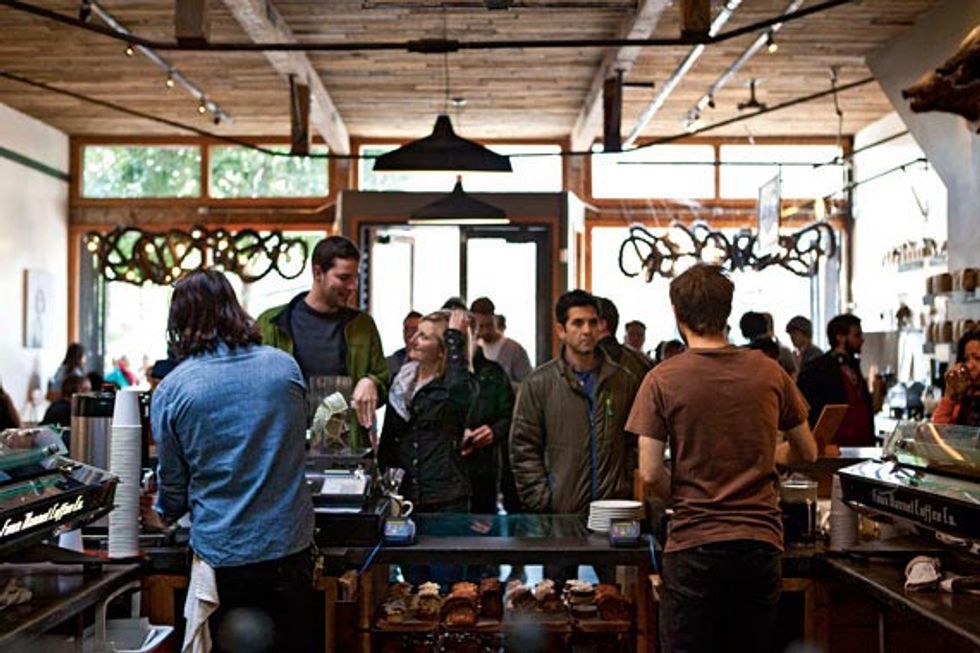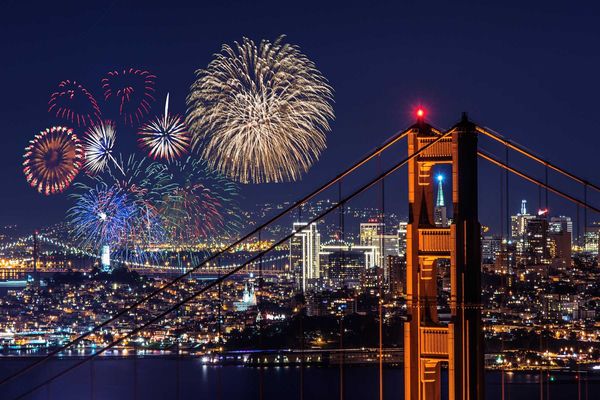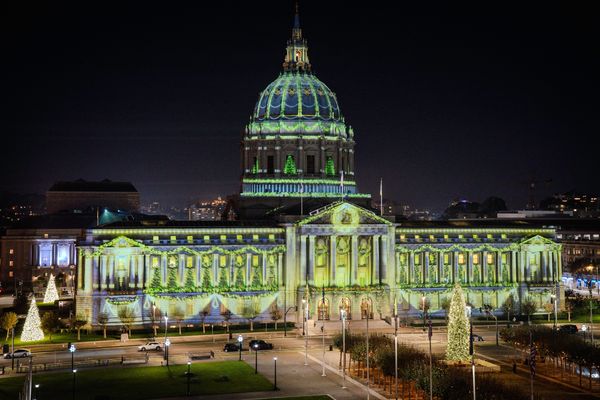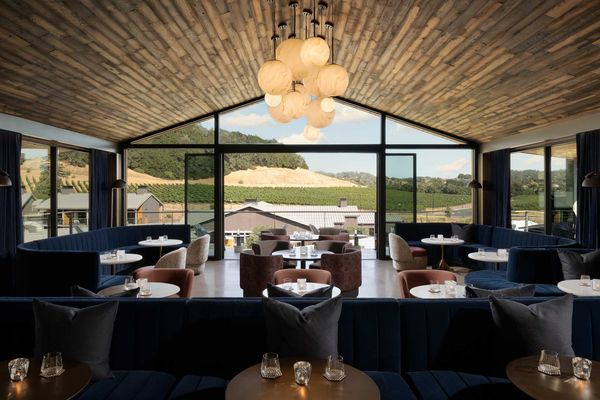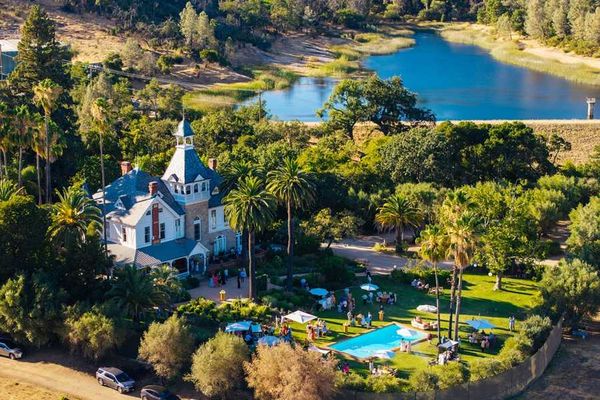At one of the city’s most revered coffee temples, the design is like a beautiful third-wave film set. From soaring ceilings with skylights, hazy sheaths of light illuminate exposed wood, cement floors, and sheet metal. A guy with tattoo sleeves listens for the crack of the coffee beans roasting in the vintage Probat, and a barista in black-framed glasses and a checkered flannel mans the Slayer espresso machine. From a vintage turntable, Van Morrison belts out G-L-O-R-I-A, yet the room has a sobering tenor of importance.
"Can I get a Gibraltar? To go, please,” I ask, smiling sweetly for good measure. The woman at the register squints with a brief look of confusion as if she’s never heard of this signature coffee drink made popular by Blue Bottle. Or as if she’s never had a customer so daft as to ask for a drink that’s not on the menu—or worse yet, a customer who requests it to go.
“You mean a short, wet cap?” she corrects me in a tone that’s just patronizing enough to get the point across, all sugar-sprinkled with some earnest concern for my cluelessness about the rules.
I already know that these types of coffee shops generally refuse to serve a Gibraltar to go. The rationale, according to coffee lore, is that it must be served in its namesake glass. But despite a hunch that my request would be denied, I still find my mojo wilting in the face of the barista’s disenchantment. My ego desperately wants to impress her with my effortless espresso-ordering lingo, to show I have a clue what a short, wet cap is, to tell her that I haven’t patronized Peet’s for years, to explain that I always grind my own coffee beans but will do better and invest in a burr grinder soon.
A few minutes later, my drink is proffered by a barista with plugs in his earlobes. I ask another loaded question. “Excuse me. Where’s the sugar?” I flinch a bit, knowing how gauche this is.
The girl at the register wanly points toward the back of the huge room—like the way, way back—to a milk-and-sugar Siberia where sinners who dare to contaminate a single-plot, microregion, micromilled, $20-per-pound Costa Rican coffee should go to practice some self-flagellation. Meekly holding my short, wet cup of coffee, I do the walk of shame.
This is a true tale, but I don’t mean to pick on a particular coffee institution. I’m just trying to paint a picture of the type of service that has come to define some of the city’s most popular places of food and drink—places that, despite having this hipper-than-thou attitude, I continue to frequent because I don’t want to miss out on the good eating and drinking. Though, I have thrown in the towel on a few occasions.
Not long ago, on a slow night at one of the city’s celebrated restaurant bars—one that I really wanted to give another chance—my husband and I were happy to be greeted by a pleasant bartender. He was on the brink of cheerful, actually. All signs were a go, or so it seemed, until he promptly turned his back to us and continued an earnest conversation about some noble spirit with a deeply nodding customer, all the while meticulously prepping, measuring, pouring, twisting, stirring, and two-handed shaking that customer’s cocktail to life. There might have been a tincture involved. There might have been shrubs. I don’t think there was fire, but there was definitely specially shaped ice. It was an ordeal. Or maybe it was art. Either way, we were forgotten. Twenty minutes went by, and there was no glass of water, no menu, no check-in to make sure we were still breathing.
I don’t think the bartender was purposely being rude. He was simply on his path, and he expected that we were happy to wait—and wait—an accepted penance for ordering a fancy cocktail. (If this scene resonates with you, please read Kate Hahn’s “I’m Your Mixologist,” which was posted on McSweeney’s website this past June, and have a good laugh.) Finally, when we left in a noticable huff to go elsewhere, the bartender barely registered our absence. There was no attempt to woo us back.
For some reason, the two B’s—bartenders (aka mixologists) and baristas—are often the biggest offenders in the current hospitality sector. Any institution of food or drink that has a cultish aura and celebrates the server’s arcane knowledge of what’s at hand is prone to such an air. Pizzaioli, butchers, sommeliers, ice cream scoopers, and croissant dealers also come to mind. And not to be anti-ink, but if you’re trying to avoid this kind of service, tattoos often serve as a red flag. Be warned of tattoos of coffee beans, chef knives (Japanese in particular), and butchery diagrams. People who give their body to their craft seem to be more likely to hold it above you.
As for picking on coffee makers, it just so happens that the third-wave world—that is the likes of Blue Bottle, Four Barrel, Ritual Roasters, Sightglass, and more—is ripe for parody. You know there’s been a public pushback when something can be effortlessly spoofed. In a Funny or Die video that was circulating on YouTube at the end of 2011, a couple of sullen baristas in dowdy-chic vintage dresses chat to each other, oblivious to the long line of people going through caffeine withdrawal.
“I’m so glad those Costa Rican beans are in season right now,” says one with pitch-perfect disaffection.
“Oh my god, I know. Those Ecuadorean beans were so harsh. I couldn’t handle it,” says the other, eyes rolling to the back of her head.
“Someone asked for milk with their coffee, and I almost gave it to them,” the first barista rolls right back.
But the ironic part of the video isn’t what happens when a woman next in line orders a caramel macchiato and the baristas give her a deadpan lecture about how this is not Starbucks (“That drink doesn’t exist. Am I wearing a green apron? Do you hear Ray LaMontagne playing right now?”). The irony lies in the fact that if I’m to be honest, I’m so conditioned to this kind of service that I’ve become skeptical of a coffee drink or a cocktail or a porchetta or a pizza made by someone who treats me otherwise. At this point, bubbly, happy service would give me pause—similarly, a third-wave coffee shop offering 1-percent milk or a serious bar touting its signature vodka cocktail. So who’s the enabler here?
Channeled positively however, some of the knowledge bursting forth from today’s food scene is a good thing. I call Doug Washington—long known as one of the city’s preeminent front-of-the-house men and co-owner of Town Hall, Salt House, and Anchor & Hope—to talk shop. As an example of a current trend in service that he’s witnessed in San Francisco and beyond, he recalls a recent trip to Portland where he found himself at an ice cream cart. “The guy manning the cart wasn’t the owner, but he knew the owners had bought six cows and a tiny dairy. He knew where they had gotten all the ingredients for each flavor,” Washington says. “The amount this guy knew blew me away. I think that this kind of knowledgeable service has bled out of the dining room. You go get coffee, you go to the butcher, and the amount of integrity and commitment is amazing.”
The flip side to too much stored data is demonstrated at Town Hall and his other restaurants where Washington says they have to remind servers to bite their tongues. “We’re always telling our staff that what they have to know is on the same level as a four-star restaurant, but don’t be waiting to shoot knowledge out,” he says. “For some customers, it’s not the evening for it. I don’t want a crew to ever think that their job is to educate people.”
Of course, customers can be just as guilty of this. Washington recalls an afternoon waiting in a long line at one of the Bay Area’s premier ice cream shops, one where you’re only allowed three tastes. “There was a customer standing at the front, asking questions like, ‘Is it organic? Do you use Straus?’ and on and on,” says Washington. “And a guy behind me finally yells, ‘Hurry up. You’re not buying a car!’ It was so great. The women working there were just jolted out of their alternate reality.”
Barring camping out at the Apple store on iPhone launch days, having to wait at great length to buy something is generally considered terrible service. But this rule doesn’t hold true for today’s dining scene where reservations aren’t taken at some of the best restaurants, and you find yourself profusely thanking the hostess for seating you after an hour-and-a-half wait in the rain. The equation goes that the longer the line, the better the food or drink must be on the other side—and often it is. Or maybe it just seems this way because by the time you actually get to eat, your blood-sugar level has made you delusional.
The city is full of long waits. There’s Tartine Bakery, where arriving before the doors even open on a Sunday for a morning bun is a right of pastry passage. On Thursdays at the Ferry Plaza Farmers Market, there’s a line for Roli Roti’s porchetta sandwich. There’s the queue at Una Pizza Napoletana, the revered SoMa restaurant where one man makes one pizza at a time and looks very serious while doing it. To wait shows your dedication to good food. Speaking of enablers, Jonathan Kauffman, the restaurant critic for SF Weekly, is a big fan of Una Pizza himself. “A line is a direct confirmation that what you’re waiting for is worth getting,” he says. “And if the service isn’t as welcoming, people are more accepting because they feel like they’ve found something special.”
Playing Angry Birds on your phone is one way to ease the wait pain. “I think it’s odd that everyone’s patience level has gone to shit with the Internet, yet I’ll watch a guy wait for 10 minutes for an espresso drink,” says Washington. “But he’s not upset about that. He’s pissed because his phone is toggling so slow.”
To wait or not to wait doesn’t necessarily make or break good customer service—it’s how you’re treated at the pearly gates once you arrive. Jake Godby and Sean Vahey of Humphry Slocombe ice cream are no strangers to customers happily standing in line for an hour to get a taste of their Secret Breakfast. “Waiting in line forces you to stop for a bit,” says Vahey. “It’s almost a social thing.” However, the two try to apply the rules they learned at finer establishments before they went into the scoop business. Godby once worked as a pastry chef at restaurants including Coi; Vahey was a food and beverage manager at the Four Seasons, a place where you learn things like the “five and ten rule,” a customer service tactic wherein at 10 feet away, you make eye contact with the customer, and at five feet, you verbally acknowledge them. “Being acknowledged,” says Vahey, “is such a simple thing.”
Danny Meyer—restaurateur, founder and CEO of Union Square Hospitality Group, and author of Setting the Table: The Transforming Power of Hospitality in Business—has spent his life thinking about this whole equation. Though he’s based in New York, Meyer is respected nationwide as the man when it comes to a philosophy on customer service. The increasing competition to be original, Meyer says, is to blame for this current mindset that the customer isn’t always right. In fact, the customer is dead wrong (again, that issue of milk in your coffee). “In order to survive today, there’s a need to have a sharp point of view—whether it’s a bar, or a barbecue joint, or a taqueria, or a coffee place,” says Meyer. “That leads people to this dogma, which says [to the customer], ‘This is what we do. You’ll have it our way, or you’ll go somewhere else.’ They think if they stop doing it their way, then they’re not being true to what made them distinct in the first place.”
For Meyer, this drive to be unique is a start, but it’s limiting if it dovetails into service. “The fact will always remain that if you give me a product that I need or want, I give you money. I expect the product is as good as you promised, and you’ll make me feel appreciated,” he says. “A restaurant’s vision doesn’t pay the bills if it doesn’t have people who buy into it more than once.” No matter how hot a restaurant, returning customers are key. You can put all the local and organic you want on a menu, but a business is only truly sustainable if people come back.
There is a glimmer that things are changing. On a midweek morning, I walk into Four Barrel in the Mission to talk with owner Jeremy Tooker, who launched Ritual Roasters along with Eileen Hassi (now the sole owner). Tooker tells me Danny Meyer is his customer service hero.
To envision a morning at Four Barrel, simply refer back to the first scene of this article: from earlobe plugs to analog, it’s the same genre but with more lumberjack beards. Meyer, who’s generally seen wearing a suit, would look really silly here. “I’m the biggest hipster in the Mission,” says Tooker, who has a tattoo of the word bacon on his inner lip. (Though he doesn’t have a coffee bean tattoo, he once flirted the idea). “The biggest self-proclaimed hipster at least. But Portland, where I’m from, was worse. The norm was to be talked down to. Good coffee meant bad service.”
In terms of stereotypes, everything about Tooker and his Fleet Foxy staff says that I should expect no less from Four Barrel’s service, but I let him explain himself. “I was only 26 when we opened Ritual,” he says. “You get a little out of control when you’re an instant success. My managing style was typical of a new business. I had an ego. Still, I’m a fan of learning from my mistakes.” I wonder if he’s feeding me this for my story’s sake, but then Tooker emails me Four Barrel’s 10-page, single-spaced, heartfelt hospitality manifesto.
Along with some basic barista tenets (“never serve anything that looks creepy or thin or wrong” and how to explain the whole-milk only rule to guests), Tooker’s guide proclaims that “the customer should never feel as though they need to win us over,” that customers “show us a small act of grace when they choose to come here,” and that therefore, they should be treated hospitably. “Put some soul into it,” he adds. “At our best, we should not let a guest leave without feeling as though they’ve been satisfyingly hugged.”
Tooker is clearly trying to answer the question that Washington posed to me earlier: “ Why can’t we have knowledgeable people make great things and have service with joy and hospitality?”
Meyer was on to something. It just might be that the new wave of businesses—the fourth wave—will set themselves apart not only with a limited menu but also with a smile. A hug, though? That might be overkill.




